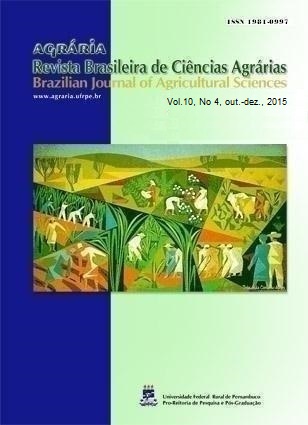Short term changes on soil physical quality after different pasture renovation methods on a clayey oxidic Red Latosol
DOI:
https://doi.org/10.5039/agraria.v10i4a4689Keywords:
load bearing capacity, precompression stress, soil compactionAbstract
Most of Brazilian agricultural land is occupied by pastures, which often show some degree of degradation. Grazing is usually associated to damages on soil structure because of soil compaction. The aim of this work was to evaluate short term changes on soil physical quality following different pasture renovation methods, including fertilization (FERT), conventional soil tillage (TILL) and two crop-livestock system (no-till and conventional tillage, respectively COTI and CONT), on a very clayey Red Latosol (Ustox), also comparing these to the original pasture and a nearby forest fragment. Bulk density and macroporosity were significantly different on the pasture sites (averaging 1.12 g cm-3 and 0.16 cm3 cm-3 respectively) from that under the forest fragment (respectively 0.87 g cm-3 and 0.34 cm3 cm-3); however, significant differences between the renovation methods and the original pasture were not observed. The load bearing capacity model (LBCM), which relates decrease on soil precompression stress (?p) with increase on water content (U), obtained for the original pasture, ORIG (?p = 10(2.82-1.21*U)), was considered different from that obtained for the soil under natural vegetation (?p = 10(2.69-1.25*U)), with the former being more resistant to compaction. When the ordinate pairs (U, ?p) obtained from soil cores collected on the different renovation methods experimental plots were plotted on the LBCM from ORIG, an increase on soil strength could be noticed, but with small differences between renovation methods. This was because of higher stocking rates on FERT and TILL and corn harvest for silage production on COTI and CONT. Tillage failed to improve soil physical quality even on the short turn (only one growing season) and should be disregarded as a renovation method for pastures on initial stages of degradation, while soil fertility is the main limitation.
Downloads
Downloads
Published
How to Cite
Issue
Section
License

This work is licensed under a Creative Commons Attribution-NonCommercial 3.0 Unported License.


